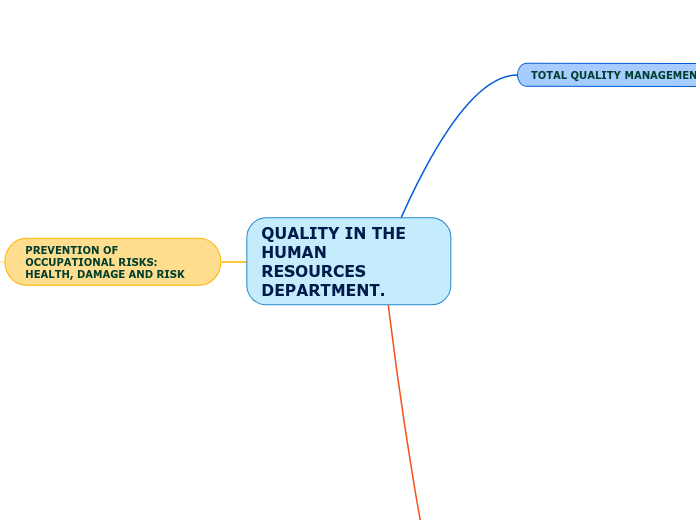QUALITY IN THE HUMAN RESOURCES DEPARTMENT.
TOTAL QUALITY MANAGEMENT
Total quality management (TQM) consists of organization-wide efforts to install and make a permanent climate in which an organization continuously improves its ability to deliver high-quality products and services to customers.
FUNDAMENTAL CONCEPTS
Subtopic
A. CONTINUAL IMPROVEMENT
B. THE CUSTOMER AT THE HEART OF THE EFQM MODEL
THE HUMAN RESOURCES DEPARTMENT AS AN INTERNAL CUSTOMER-SUPPLIER
Supplier of the administration department
Provides information to the accounting area about:
• Payroll, withholding and payment of social security contributions, withholding and payment of personal income tax.
• Termination benefits
Supplier of the financial department
Provides information for the payment of salaries, social contributions and the payment of IRPF deductions, indemnities, etc...
Supplier of other departments
• Professional profiling, recruitment and selection.
• Recruitment, affiliation, registrations and cancellations
• Dossier management
• Preparation of payroll and personal income tax deduction certificates
Customer of other departments
Departments are required to provide information to the human resources department on:
• Absences, delays, illness and accidents
• Production bonuses, incentives, etc....
• Vacation, leave, night shift, shifts, etc.
• Overtime worked.
PERSONAL DATA PROTECTION AND CONFIDENTIALITY REGULATIONS
HR data has now become a critical success factor for organisations both internally and externally. Internally, because an effective and sustainable personal data management supports the works of everyone in the organization who relies on those data. Externally, because personal data has now become a crucial issue closely linked with managing trust and competitiveness while trying to grab the best human capital in the industry.
Spanish Agency for data protection (AEP) is the authority that enforces data protection legislation. Spanish law provides very substantial fines for violating the Protection Act for Personal data (LOPD).
All organizations, both public and private, have large amounts of information, which is accessed by employees or citizens, transmitted via computer networks, etc. In the specific case or private companies, there is a lot of sensitive information that is in danger: customer data, billing, information about employees, etc. Therefore, if that information is lost or becomes public in an unauthorized way, the organization would not only lose its credibility, but also customers, and probably would be involved in a series of lawsuits. Hence protecting the information is a very important issue for companies.
PROCEDURE
1. Notifications of files to the Spanish Agency for data protection.
2. Draft a “Security document”
3. Sign contracts about assignment of data processing.
4. Inform interested parties about the company are complying with all the regulations.
PREVENTION OF OCCUPATIONAL RISKS: HEALTH, DAMAGE AND RISK
Workers should be protected from occupational risks they could be exposed to. This could be achieved through a risk management process, which involves risk analysis, risk assessment and risk control practices. In order to carry out an effective risk management process, it is necessary to have a clear understanding of the legal context, concepts, risk analysis, assessment and control processes and the role played by all involved in the process. It is also desirable to base risk management on solid and tested methodologies.
Risk analysis
Identification of hazards present in the workplace and work environment;
Identification of hazards discovered in previous risk management;
Identification of potential consequences of the recognized hazards – risks, i.e. the potential causes of injury to workers, a work accident, an occupational disease or a work related disease.
Risk assessment
Risk assessment is the process of evaluation of the risks arising from a hazard, taking into account the adequacy of any existing controls and deciding whether or not the risks is acceptable[1]. Several methods to perform risk assessment are available ranging from expert to participatory methodologies and from simple to complex methods. Risk assessment involves evaluating, ranking, and classifying risks.
Risk evaluation
Risk evaluation involves the determination of a quantitative or qualitative value for the risk. Quantitative risk evaluation requires calculations of the two components of the risk: the probability that the risk will occur, and the severity of the potential consequences. This approach is seldom applied in practice.
Slips, Trips and Falls
Universal slip, trip and fall culprits include unattended spills, wet floors, exposed cords, unstable work surfaces, uneven floors, loose rugs and cluttered areas.Clean up all spills immediately, and post signs identifying hazards in areas that are being cleaned or that have recently been cleaned, and in areas prone to water accumulation and wet surfaces
Ergonomic Injuries
Position the chair, keyboard and monitor in a straight line with your body.
Maintain a relaxed, neutral posture.
Sit up straight, adjusting the chair to provide firm back support.
Let your arms hang loosely at the shoulders.
Keep your elbows at a 90-degree angle while typing.
Use an adjustable keyboard tray to position your keyboard and mouse at a comfortable height (usually lower than the desk surface). Place your mouse next to the keyboard, and keep it as close as possible to your body, to avoid reaching.
Adjust the chair’s height so that your feet are firmly on the ground.
Eye Strain
You can cut down on excessive glare by closing blinds on windows and dimming the overhead lights. Correctly positioning monitors slightly below eye level, minimizing screen glare and increasing computer font size all can help alleviate eyestrain.
Fire Safety
Power cords should be inspected regularly for wear and be replaced if they are frayed or have exposed wire.
Cords should never be used if the third prong has been damaged or removed.
Cords should never overload outlets. The most common causes of fires started by extension cords are improper use and overloading. Extension cords should be approved by a certifying laboratory, such as Underwriters Laboratories, and be used only temporarily to connect one device at a time.
Indoor Air Quality
The office’s air quality can be greatly improved by proper maintenance, cleaning and filtration of the ventilation, heating and air conditioning system. This will help reduce respiratory irritants, infections and illnesses, the NSC said
